elysion
Been here a while!  Team Anti M$ AND Facebook.
contra torrentem
Team Anti M$ AND Facebook.
contra torrentem
Posts: 2,375
|
Post by elysion on May 29, 2010 4:32:57 GMT
Maybe some of you have read my thread about the Native Instruments Audio 4 DJ DAC. The NI A4DJ DAC was really nice regarding SQ (24-bit/96KHzk CirrusLogic based USB DAC), but its INSANE output-gain of about +10dBu almost killed my ears. It's simply to much gain for use with standard headphone amps. Of course you could use a mixing console or something other to limit the gain, but I think it's not intended to work so. I'm searching for good USB or FireWire DAC for use with my various computers (I have lots of them) and the search is still not over. Although I want a very good DAC to get the most of my amps and headphones, I have also a need for cheaper but still usable USB DAC, this because I have so much computers. One DAC isn't enough at all. For pasttime while I'm still searching for THE USB DAC, I bought a Behringer U-Control UCA222 USB DAC yesterday. It's not only a DAC, it's also an ADC. The UCA222 has RCA outputs and inputs and one toslink optical output. Additionaly it has also a mini-jack headphone monitoring output. Connection to the computer is only through USB 1.1 (no need for a USB 2.0 port) and almost every computer with USB is capable of using this interface (no additional drivers needed). The interface is rated to have 16-bit/48KHz output and is entirely USB bus-powered. Installation on the Mac was very easy. Plug-the USB cable in and select the UCA222 as audio input and output device in System Preferences – that's it. 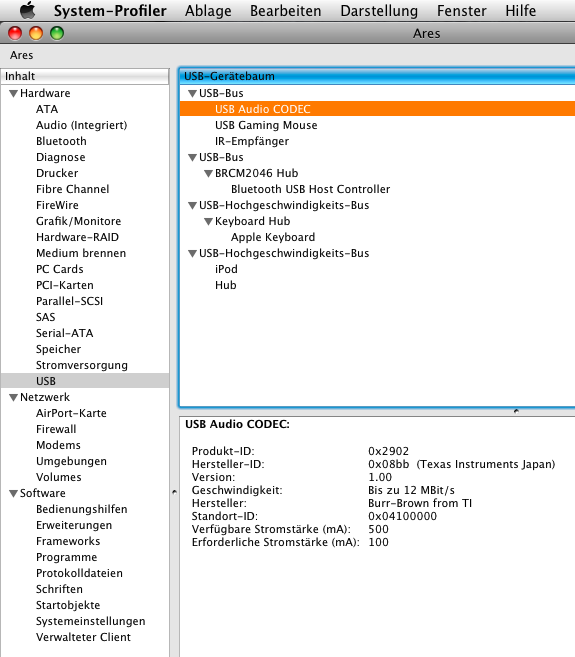 According to the SystemProfiler output the UCA222's use some Burr-Brown USB interface chips. Im only using the RCA outputs and maybe I have also use for the RCA inputs sometime. The UCA222 is brand new and had no burn-in and I have only listened a couple of hours to it. I used it as source for the Neco Mosfet V.2. Initial impressions are quite good. Sound quality isn't high-end, but it's a real bang-for-the-buck. Never seen a cheaper USB DAC. I'm thinking of buying at least one additional UCA222 because I'm rather pleased with the output quality and because it's so cheap. I can easily use them for my bunch of computers even when I get a state-of-the-art DAC for my main computer. Because they are so cheap and I'll getting at least one more soon, I can easily make some inside pictures of the UCA222. I'll wait until I've gotten the additional UCA222, but I don't think it's a problem to void warranty with one of them...  The case is made from two plastic parts that are fixed by two screws. I hope there are not also additional plastic snap-in's (I hate them). I have found two videos about the UCA222 on YouTube: www.youtube.com/watch?v=uhoHiM8zmvw&feature=youtube_gdatawww.youtube.com/watch?v=bgqmC7A6qC4&feature=relatedThe metallic-red plastic case looks a bit better in real than on pictures/moovies. But it still looks somewhat cheap... OK, it IS cheap...  I don't want to comment much about sound quality at the moment. For now the UCA222 has only very low hours on it and I don't have much other DACs around to compare with. I hope my DAC armory is growing in the next few months though. I'm almost sure the sound quality is acceptable for use with most amps. The UCA222/Mosfet combo isn't bad at all and I'm listening with pleasure to it at the moment. The output gain of the UCA222 is as far is I know on normal line-out levels, but I have the strong feeling that it has less power than the analog out of my Macs and for example the Yamaha TX-592RDS tuner that I'm using for the burn-in of headphones. It's not a bad feature, I have no problem with it. But you shouldn't expect a very powerful output. The log POT of my Neco Mosfet V.2 is a bit better usable than with other sources, but it's not a major difference beside the NI A4DJ DAC which has INSANE output gain. |
|
elysion
Been here a while!  Team Anti M$ AND Facebook.
contra torrentem
Team Anti M$ AND Facebook.
contra torrentem
Posts: 2,375
|
Post by elysion on May 29, 2010 9:01:46 GMT
Product information on the Behringer website: www.behringer.com/EN/Products/UCA222.aspxIt's to early to give a final statement about sound quality. But I can say something for sure: This USB audio interface sounds extremely soft and sweet. I think it does lack the details that better DACs do offer. In contrast to the lacking resolution the sweetness is outstanding. I must admit that I do like this sweetness. Maybe I should call the UCA222 the "Sugar-DAC" – everything sounds like it's sugar-coated. Together with the Neco Mosfet V.2 and K702's I do hear absolutely no harshness. The sweetness of this DAC allows very relaxed hearing without any fatigue. I miss the resolution of the NI A4DJ DAC and also some details, but the sweetness does compensate a lot. It's very easy to forget with this combo that you are wearing headphones at all. There's certainly no need for a "smoothing device" like the X10-D in this chain. I have an unmodded X10-D with two news JAN 6922 tubes and like it especially with the analog out of my Macs. The sound from the UCA222 is a lot sweeter than what I got from the X10-D. I'm very curious to try other combos, including those that have showed problems with harshness. Given the very low price of this DAC, I can't do anything other than to rate it as very good. It's no perfect regarding resolution/details, but the sweetness makes it very pleasant for very long listening sessions. It's a good bang-for-the-buck and offers a good value. |
|
elysion
Been here a while!  Team Anti M$ AND Facebook.
contra torrentem
Team Anti M$ AND Facebook.
contra torrentem
Posts: 2,375
|
Post by elysion on May 29, 2010 9:26:12 GMT
If someone else is trying the UCA222 also, please note that I have tested only with OSX so far. Behringer supplies special low latency drivers for Windows although the built-in drivers of Windows should work also. I suppose that latency is a problem with the built-in Windows drivers.
To me the Mac drivers seem absolutely OK. Very good SQ for such a dirt cheap low-end device.
Feedback from Windows or Linux users is highly appreciated. I wonder if there are more than minor differences in SQ.
I will report back as soon as I have tested more combo and maybe operating systems.
|
|
elysion
Been here a while!  Team Anti M$ AND Facebook.
contra torrentem
Team Anti M$ AND Facebook.
contra torrentem
Posts: 2,375
|
Post by elysion on May 29, 2010 13:00:37 GMT
I couldn't wait.  I was out to get another one...  Here are the PICS:  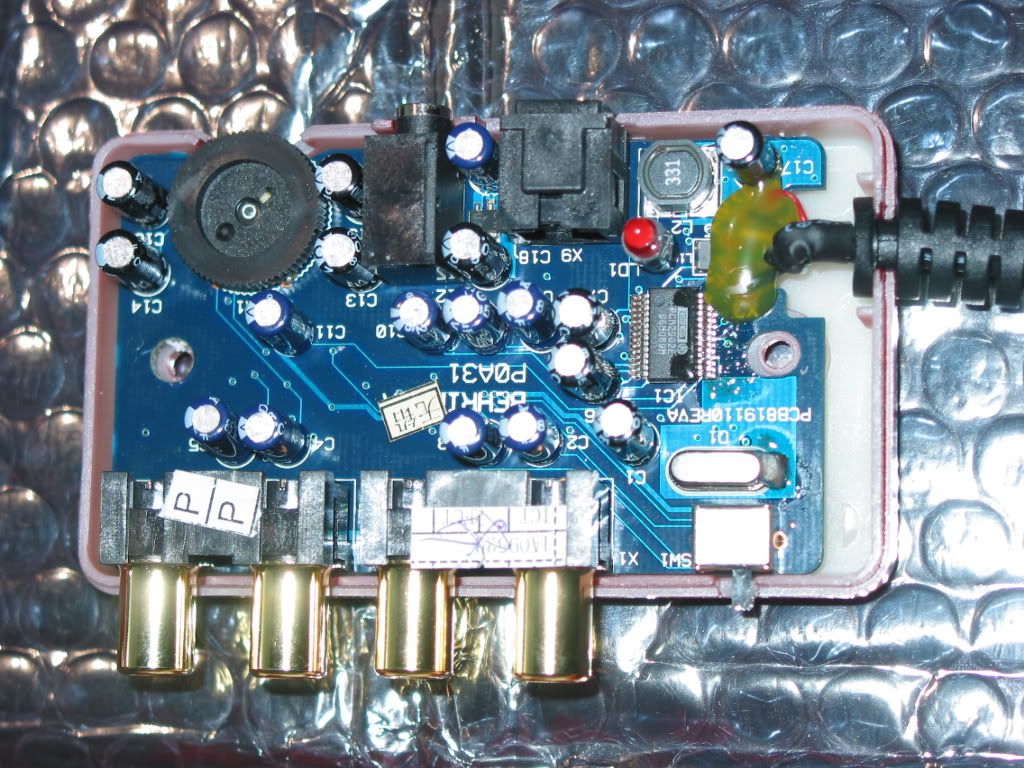     The USB-interface and DAC chip is a Burr-Brown PCM2902E. All caps are of 85 degree Celsius type. I think this rating is no real problem as the UCA222 doesn't get warm at all... I don't have much knowledge of electronics but all caps seem to be rather cheap ones. Some are marked with "DECON SAII" and others with "KSD GR". I think there are caps of two manufacturers used, but beside this there are quite a few type of caps with varying capacitance used. Opening the case was very easy. Simply remove both screws on the backside and take it apart. No problem for warranty too as there is no seal or something other that would indicate an opened case. As mentioned, I don't have much knowledge about electronics, but maybe the UCA222 would be a candidate for modding. I don't know if better caps would make a difference though. The SQ is nice for the price. I paid 49CHF for each, today this is about 30£. |
|
elysion
Been here a while!  Team Anti M$ AND Facebook.
contra torrentem
Team Anti M$ AND Facebook.
contra torrentem
Posts: 2,375
|
Post by elysion on May 29, 2010 13:14:37 GMT
I forget something: At least with the UCA222/Mosfet V.2/K702 combo I don't hear any noise/hiss or whatever when I hit the pause button in iTunes. Total silence so far... also if I put the POT of the Neco Mosfet V.2 to 5:30...
The lacking resolution is a (slight) problem and sometimes I would wish a bit more power. But overall it's very musical and allows very relaxed listening.
|
|
|
|
Post by derekrumble on May 29, 2010 16:01:16 GMT
The Behringer reminds me of my Creative Soundblaster USB card .....  I bought it to upgrade the on-board soundcard on a Pentium 3-based Dell machine I had a few years ago. The Creative card did a grand job. Optical digital ins & outs, analogue ins & outs, headphone monitor socket with volume control. A good, smooth easy-to-live-with sound. USB -powered, 16/48 capable and pre-USB 2.0 too. Tried to try it out with my new Acer laptop but it won't work with W7 and Creative no longer support such an old soundcard. Another low-cost surprise is my Alesis USB mixer....  (Only) 24/48 capable but a great sound; works cool as a headphone amp and very good EQ too if needed. I have mentioned this piece of kit before, I know, but HOW do they knock these out at such a low price? When you consider the sheer number of sockets, knobs, ICs and LEDs - and all for about a hundred quid. That Creative card of mine ... must open it up and see if resembles that Behringer in any way. |
|
|
|
Post by derekrumble on May 29, 2010 16:12:44 GMT
Found this. Saves me looking inside. It uses the AD1885 chip from Analog Devices.  |
|
elysion
Been here a while!  Team Anti M$ AND Facebook.
contra torrentem
Team Anti M$ AND Facebook.
contra torrentem
Posts: 2,375
|
Post by elysion on May 30, 2010 6:35:48 GMT
Thanks for the nice additions here, Derek. The point is that not everything has to be "high spec" to sound good. Sometimes an el-cheapo solution can deliver astonishing results. I remember to have heard a very old Creative Soundblaster AWE32 for the ISA bus. Its mini-jack output was very powerful and sounded extremely good. There was also and even better variant of this card, the Soundblaster AWE64 Gold, also for ISA bus. Never heard this one, but it had gold-plated RCA outputs. In theory it should be possible to use this cards with some modern industrial mainboards that still do have an ISA slot. Together with an appropriate Linux distribution I can imagine, that it would be not a big problem to use it with modern software for playback (like Amarok or XMMS for example). Maybe Linux is also an option for your old Creative USB audio interface. Usually almost any Creative product has good Linux support. Maybe a good idea if everyone on the forum would take a closer look at his older and/or low-spec USB/Firewire audio hardware. I'm pretty sure there are a few more suprising devices out there. The UCA222 has no shielding. Maybe the following would be an option (no clue if it would improve anything): The new case looks better than the older black type. At least I DO like it. BTW: I just remembered to have seen sprayable EMI-shielding. I know it's not necessary for the Pinkies, but maybe this would be a easy way to add shielding to the plastic enclosures of cheap products. I've seen such EMI-shielding spray on old IBM computer parts. As far as I know it's a "paint" that contains a lot of conductive metal particles that are sprayed on the part that you're like to shield from EMI. IIRC I can get this spray from a big electro/electronics company here in Switzerland, but it's not cheap. Maybe it would be possible to make a DIY EMI-shield-paint which isn't sprayed but painted on then. Probably it's all about the right metal particles mixed into some type of glue/paint. An other (quite expensive) option would be the use of silver conductive paint to create a EMI shield within the existing plastic case. Silver conductive paint would be a lot easier to handle because you could apply the paint with a simple brush. Painting of the contact areas of both case halves would be also very simple. I used to have a very small quantity of silver conductive paint aroud. I'm not sure if I still have it. Maybe I can find some cheap paint that has good conductivity. Here is another picture of the software settings in OSX: 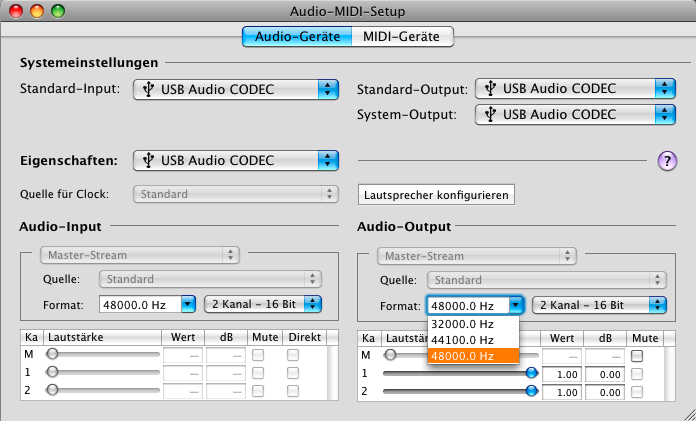 Output was configured initially as 16-bit/44.1KHz. I changed it to 16-bit/48KHz a couple of hours ago and I can't hear any real difference. If there's an audible difference then it's small and it shouldn't matter with most music which is usually 16-bit/44.1KHz. I have already found a possible new toy: www.behringer.de/EN/Products/FCA202.aspxI'm seriously thinking about pulling the trigger on a FCA202. The experience with the el-cheapo UCA222 was very positive and I have found rather good feedback about the FCA202 while googling for information. I hope that others also give the UCA222 a chance. There's almost no risk given the very low price. It remains a very interesting question how those Behringer interfaces behave with different operating systems. OSX CoreAudio built-in drivers are high-quality and offer low-latency, Windows built-in drivers don't. The special drivers that Behringer offers for Windows strongly indicate that the built-in Windows drivers don't perform equally. Both the UCA222 and the FCA202 use OSX built-in drivers. This a important argument for me because it makes the interfaces very easy to use. FireWire is a lot better for music than USB. No need for special asynchronous drivers as FireWire uses a SCSI-3 command set. The FCA202 is also a bargain, probably one of the cheapest FW interfaces that are around. If you use an USB DAC with your Mac, I strongly suggest you to use it with OSX 10.5.x (Leopard) ord 10.6.x (SnowLeopard) because the USB performance of OSX 10.4.x (Tiger) was lacking somewhat. Leopard and SnowLeopard are better in this regard. I feel cheated with the NI A4DJ interface, most likely I will sell it soon. It's OK for DJ work together with PA amps, but nothing for a setup with a headphone amp. I'm still listening to the UCA222+Mosfet V.2+K702 combo. Probably I'm keeping this for some time, I need to hear more music and moovies with this combo. Looks like a lot of work to compare the UCA222 and maybe the FCA202 with all gear that's lying around here. Probably I need a couple of weeks for more insight and better verification. Any help is much appreciated. |
|
elysion
Been here a while!  Team Anti M$ AND Facebook.
contra torrentem
Team Anti M$ AND Facebook.
contra torrentem
Posts: 2,375
|
Post by elysion on May 30, 2010 6:49:49 GMT
BTW: I have found the data sheets of the Burr-Brown PCM2902(E): focus.ti.com/docs/prod/folders/print/pcm2902.htmlThe PCM2902 is manufactured by Texas Instruments for Burr-Brown. Burr-Brown is only the designer of the chip. With good drivers the PCM2902 uses USB adaptive mode for playback and asynchronous mode for recording. As far as I know adaptive transfers are rather close to asynchronous transfers regarding sound quality. I can't prove what transfer mode OSX uses for playback with the PCM2902. Maybe I can find a hint how I can prove it... it can't be too bad since it does sound good. |
|
|
|
Post by rainman on May 30, 2010 23:02:29 GMT
Elysion, Thanks for the recommendation. I actually came across this along with the Behringer UCA20. What is the difference? Please bear in mind that I know absolutely nothing about DACs, other than that they convert digital to analogue  |
|
elysion
Been here a while!  Team Anti M$ AND Facebook.
contra torrentem
Team Anti M$ AND Facebook.
contra torrentem
Posts: 2,375
|
Post by elysion on May 31, 2010 0:10:59 GMT
Hi Omar,
as far as I know, there's no real difference between UCA222 and UCA202 beside the case color and software bundle. Maybe I'm wrong but the two devices look almost identical. I'm almost sure as the PCM2902E has toslink output which both do have. If you buy an UCA202 then it would be great if you could post inside pictures for comparison. I can't comment about the sound quality that you're getting with Windows or Linux. SQ is suprisingly good with OSX 10.5/10.6. Not as much resolution and details as better USB/FireWire DACs have, but IMO it does sound very smooth and sweet.
I'm also no DAC expert and my knowledge is limited too.
I bought the UCA222 basically for pasttime while I'm searching for a really good DAC. It was a big surprise that the UCA222 sounds very pleasant. I'll have to do a lot more testing to say more about it, but since you also have a Neco amp, I'd guess it should very similar to what I have here. The Behringer's aren't high-end interfaces. It's just big-bang-for-small-buck. Nothing more but also nothing less.
Christian
|
|
|
|
Post by rainman on May 31, 2010 18:47:29 GMT
Hi Christian, I tried to do a bit of research on the two models- the software seems to be the difference. Though I did notice on Amazon there were some comments about hiss while recording with the 202. While I have no plan for recording, the reviews on the 222 seem to make it the safer option. Though it would be nice to be able to compare its guts on the forum  How does it compare to an iPod in terms of SQ? Is it better than the built in DAC in the iPod? Also, is it better than the built-in DACs in most CDPs around £150-£200 mark? (175-235 Euro approx) Regards, Omar |
|
elysion
Been here a while!  Team Anti M$ AND Facebook.
contra torrentem
Team Anti M$ AND Facebook.
contra torrentem
Posts: 2,375
|
Post by elysion on May 31, 2010 19:10:26 GMT
I can't comment much about the DACs of CD-players (there're so many CD-players...). You can't do much wrong when buying the UCA222. It's a really good value for the price, but don't expect the performance of devices that cost a lot more. Anyway: At least in combination with OSX you should get a very pleasant sounding DAC with the UCA222. Your results may vary, especially if you use Windows. As far as I know the built-in drivers of Windows aren't perfect (to say the least) and the I don't know how good the special drivers from Behringer are (you have to download these on the Behringer website). I can talk only for the OSX (built-in) drivers. Those are top-notch IMO. I'm using currently the Behringer FCA202 (I've bought one today). It's a FireWire audio interface and like it's brother UCA222 it's dirt cheap for what it does. I can't say much more about it, I need to listen/test more first. Please see this thread for FCA202. In your situation, I would simply buy a UCA202 or UCA222. It's so cheap that it's simply not worth to think too long about the sense or non-sense of this device. But one and listen yourself. I don't think 30£ are a lot of money for most of us (at least as long we have a job and earn money for our work). I can't guarantee any of your results, since you are using Windows. Drivers are very important for the performance of an audio interface. (BTW: IMVHO Windows sucks.) The difference between the UCA202 and UCA222 is only the software bundle and the case color, but I can't open a UCA202 since I only have UCA222's. For me the software bundle doesn't matter at all. I use the built-in OSX drivers and don't need any additional software/drivers. Look at the Behringer website: If both devices use the same Windows driver, then I'd take the device that is cheaper (as long as you don't use anything that is included in one of the software bundles). I can't comment on the inputs, I'm using only the output. My UCA222 has absolutely no hiss/noise or whatever. It's totally silent as long no sound is played. If you'd get some hiss/noise with Windows then you can say "thank you" to Bill Gates for creating a crappy operating system with an obsolete audio architeture... I'm curious about your results if you buy one. |
|
elysion
Been here a while!  Team Anti M$ AND Facebook.
contra torrentem
Team Anti M$ AND Facebook.
contra torrentem
Posts: 2,375
|
Post by elysion on Jun 6, 2010 22:25:13 GMT
I have found a couple of other cheap (and old) interfaces that work with OSX. www.xlr8yourmac.com/audio/cheap_mac_USB_audio_cards.htmlI can't comment about the soundquality of those audio interfaces (beside the UCA222). The xlr8yourmac article is rather old. I hope that I can find a couple of older USB and FireWire interfaces in used condition for a good price. OSX built-in drivers are of good quality and I expect to hear more cheap audio interfaces with suprising results. Linux could be also very interesting because a lot of older audio hardware (for ISA, PCI, PCMCIA, USB, FireWire) is supported well while "official" support ended long ago. Linux has also very good latencies (like OSX) and there are a lot of free programs for audio playback and editing. |
|
elysion
Been here a while!  Team Anti M$ AND Facebook.
contra torrentem
Team Anti M$ AND Facebook.
contra torrentem
Posts: 2,375
|
Post by elysion on Jun 6, 2010 23:08:09 GMT
Very interesting... there's "USB ASIO driver": www.usbaudio.com/A third-party asynochronous USB driver for Windows and OSX. It's a commercial product for which a demo is available. I will NOT use this driver on my normal Macs as I have already read about problems with it or more accurate about problems to restore the built-in OSX drivers after trying this... maybe I'll give them a chance on a Mac that I'd prepare specifically for such a test. I don't like damaged drivers/operating systems and this driver is certainly not without risk. The built-in OSX drivers already are good – no real need to change them. I'm sure that I don't need this driver for the UCA222 (no asychronous support at all) and the FCA202 (which is a FireWire device that supports asynchronous transfers out-of-the-box via the SCSI-3 command set of FireWire). Maybe it's something else with Windows as the Windows built-in drivers are said to be only mediocre and often third-party drivers are used. But in any case: Backup first before you are testing such drivers on a system that is important for you. The list of supported hardware is interesting though: "The commercial version of the USB Audio ASIO driver supports Alesis' USB mixing desks, ART USB, Audiotrak EX / EX5 / Maya 5.1 USB (48kHz only), Audiotrak EX7 / Maya 7.1 USB, Audiotrak OPTOPlay, Creative Audigy 2 NX (48 kHz only / not on Mac OS X yet), Creative Extigy (48kHz only), Creative MP3+ (48kHz only), Creative SoundBlaster Live 24bit external, Digidesign Mbox, Elektor USB audio, Event EZBus, Edirol UA-1A (44.1kHz only), Edirol UA1-X, Edirol UA-3(D), Griffin iMic, Griffin PowerWave, HHB Portadisc, Hercules MusePocket (48kHz only), I-O Data D2VOX, Lexicon Omega, M-Audio Audiophile USB, Opcode DAT-/SonicPort (optical), Onkyo MSE-U33(HB), Onkyo SE-U55(X(S)), Philips Aurilium (48kHz only), Roland-ED UA-30, Sitecom's 5.1 Audio Adapter (48kHz only), SKNET Digital Sound Station, Terratec Aureon 5.1 USB (48 kHz only), Vivanco 5.1 Audio Converter (48kHz only) and Waveidea UASC-1." |
|
elysion
Been here a while!  Team Anti M$ AND Facebook.
contra torrentem
Team Anti M$ AND Facebook.
contra torrentem
Posts: 2,375
|
Post by elysion on Jun 20, 2010 23:48:06 GMT
I have posted this in the AUNE Nano USB DAC thread, but at least partially it belongs also to the UCA222 thread: I have received the AUNE Nano USB DAC from Mike. It works without problems with the OSX built-in drivers. I hear also the background hiss that Mike has mentioned. 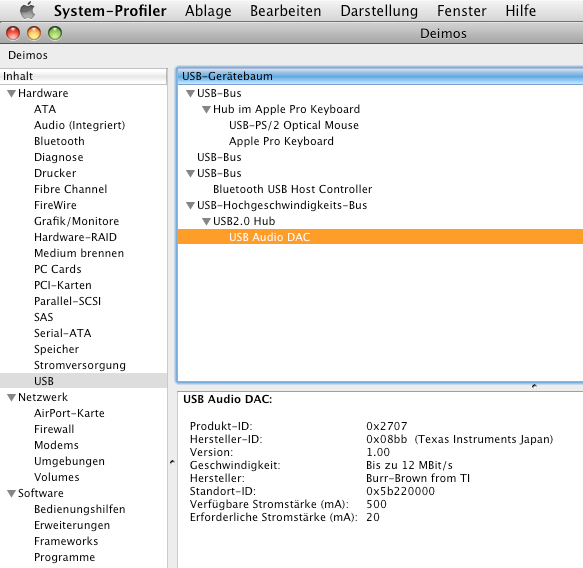 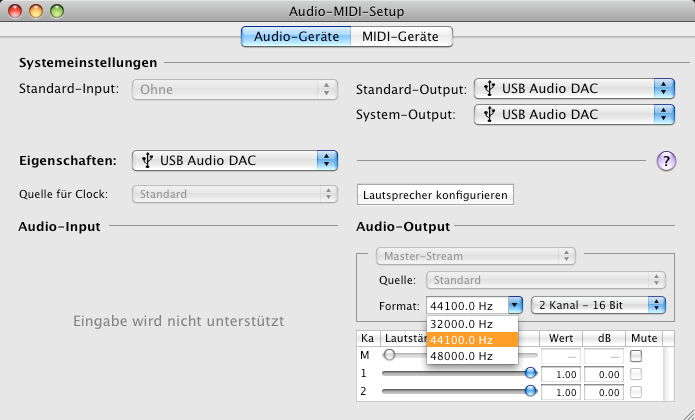 The Nano DAC only runs with 9VDC wallwart. The device draws almost no bus power (20mA according to SystemProfiler) and can't run with bus power only. I have compared it quickly with one of my Behringer UCA222's which is even cheaper than the Nano DAC. The Nano DAC uses the Burr-Brown PCM2707 while the UCA222 uses the PCM2902. I have stated in the UCA222 thread that I don't hear any noise/hiss when I hit the pause button in iTunes while turning the pot to the maxium. I must correct this statement now: While comparing the UCA222 with the Nano DAC, I have noticed that there is a very slight background hiss that is hearable for not more than about two seconds after I have hitted the pause button. I'm rather sure the UCA222 stops the output totally after there's no input for about two seconds. Maybe some kind of hibernation, but perhaps this was an attempt of Behringer to cover the tracks... Anyway, you won't notice any hiss with the UCA222 under normal conditions. As long as music is running it's also not noticeable with the Nano DAC. IMO the Nano DAC has more details/resolution than the UCA222, but the UCA222 is still smoother and sweeter sounding than the Nano DAC. I'd prefer the UCA222 over all. UCA222 is entirely bus-powered and draws 100mA from the USB bus. That's a good thing because usual USB ports can give a maximum of 500mA. You still have 400mA left on the USB port for other uses. Maybe I can improve the Nano DAC slightly with the use of an other wallwart, I'm already looking for a replacement. I was a bit suprised that the Nano DAC doesn't run with bus-power, but perhaps the higher capacitance of its caps draws to much power. Otherwise I think both DACs have a lot of similarities. I don't really like the USB port of the Nano DAC. The socket is somewhat to short IMO. USB cables that are plugged in are hanging a bit loose. The Native Instruments Audio 4 DJ audio interface has an USB port that gives a very good hold to cables plugged it. It's a different story with the UCA222: This one has a built-in USB cable whose wiring goes directly to the PCB. The UCA222 is also a lot smaller than the Nano DAC. IMO the UCA222 is much more suited for portable/notebook use than the Nano DAC. The Nano DAC has it's advantages – higher resolution and a different sound signature – but I think the UCA222 is clearly the better value. I did a swap with Mike and got his Nano DAC cheap. Although the Nano DAC isn't really better than the UCA222 (and far away from the Behringer FCA202), it's still a welcome addition to my DAC armory. I hope to find a cure for the background hiss which is IMO one of two things that are slightly annoying. The second thing is the wallwart. The UCA222 and the FCA202 are running fine with bus-power only. I don't see a real reason why the Nano DAC must have a wallwart for operation. The UCA222 has caps with less capacitance, but the Nano DAC doesn't sound better at all. Given the lower price of the UCA222 (about half the price of the Nano DAC) the real advantage is minimal. The Behringer UCA222 seems to be a rather good design that gets the maximum out of its cheap components. The FCA202 is quite similiar: Very good value for the price and quite appealing performance. I'm rather sure the FCA202 doesn't use the best available components too. But both Behringer's offer big-bang-for-small-buck. If I could wish what should be changed with the AUNE Nano USB DAC, then it would be this: – No built-in headphone out at all. I use it as DAC and not as headphone amplifier. – Better USB connector. – Powered by bus-power only. – The switch would be almost senseless if the DAC would run with bus-power. – A matt anodized finish. The shiny finish of the anodizing gives it a somehow cheap look. With some light conditions the shine looks almost in a mother-of-pearl style, almost a kind of paint that is slightly color-shifting. Beside the silver outlook the shine is kind of similar to cadmium treated surfaces. – I don't need the coax SPDIF input. I could live without it, but it makes the it more universal. Maybe the SPDIF was one of the reason why the Nano DAC doesn't run without the wallwart. For SPDIF-only use no power is available over USB at all, here we need the wallwart as power source. Overall the Nano DAC could be cheaper with the suggestions above. What about an USB-only DAC? For half the price but with better overall value? |
|
|
|
Post by rainman on Jul 29, 2010 17:54:15 GMT
I must first apologise Christian, for writing this so long after I promised I would. Unfortunately, my personal circumstances have not been as great as one would wish for. I have had this budget DAC for a couple of months now, but not had much chance to use it as much as I would have liked. Though I have no dedicated DAC to compare to, in comparison to my laptop headphone out and my netbook virtual "line out", it is in a completely different league re sound. But that's no surprise; if it wasn't, I would be a little disappointed. I use it most with my Neco V1 Bass Boost (AD8066) and V2 (8610) chips driving my Superlux HD681. I also use it with my V Can and Senn HD 650 (my preferred combination as I think that the bright V Can compliments very well the HD650. Haven't used it with the HD555 yet, but I plan to try that. I haven't listened with the HD650 at the other end of this DAC for a while, so I hope to come back to that when I do pair them up again. With the Neco amps and the 681, I must say that the sound is to my ears great! There is lots of detail, it not surprisingly leaves the ipod far behind. It feels flat; I can't detect any bias anywhere in the frequency range, but then none of my phones are completely flat- they're all fun! No frequency to my ears stands out over an other, taking into account the personal signature of each pair of 'phones. It feels, to me at least, natural; and that's what I like about it. I don't like a completely flat sound (I'm a Senn fan, and now a HD681 fan too), but I like the phones and the amp to tailor the sound, not the source or DAC- too many variables IMHO (which may spoil the broth  ). And listening with the 681 today, I can safely say it doesn't conflict with the slightly excessive brightness of my unmodded Superlux K240  I think that for anyone who uses, or would like to use more often, their computer for music or other worthwhile audio, and does not have a dedicated DAC, to give this a try. It's only about £30, and I think it is great value. While I can't compare other DACs, let alone more expensive ones, my experience is is that once something sounds really good, it is disproportionately expensive to improve on it. Though this doen't apply to audio gear alone, the HD681 is the most favourable example of this that comes too mind!  Hope this is of some use to everyone! Omar |
|
elysion
Been here a while!  Team Anti M$ AND Facebook.
contra torrentem
Team Anti M$ AND Facebook.
contra torrentem
Posts: 2,375
|
Post by elysion on Jul 29, 2010 20:03:30 GMT
Thanks for sharing your experiences, Omar.
I suppose you had no problems with the Windows built-in drivers and/or the Behringer low-latency drivers for Windows, is that correct? Did you hear any difference between the built-in Windows drivers and the Behringer drivers?
Since I have no computers running Windows at home, I'm very interested how the UCA222 behaves in a Windows environment. OSX performance of the UCA222 was already good.
I've stated in former posts that the HD650's sound good with the Neco's, but that K702's are even better for me. You made me listen again to Sennheiser HD650's and HD580's. I must admit that my oppinion has changed slightly since then.
I'm still loving the K702's with both Neco's (the Mosfet is clearly the better amp with the K702's though), but I also rediscovered my HD650's with the Neco's. The HD650's + Neco Portable combo is very good IMO and it gives you just the right amout of bass (not to much for my taste). Another surprise was the HD650's with the Neco Mosfet: It's a slightly more laid-back sound than with the Portable, it's also a bit smoother sounding.
In the last few days, I used the HD650's even more than my K702's... I really like to ability to switch between some good 'phones. After a few months with the K702's as my main 'phones, I got used too much to them.
I've got also very good results with the cheap SilverCrest (Lidl) KH2347 'phones.
|
|
elysion
Been here a while!  Team Anti M$ AND Facebook.
contra torrentem
Team Anti M$ AND Facebook.
contra torrentem
Posts: 2,375
|
Post by elysion on Jul 29, 2010 20:06:31 GMT
BTW: I'm still waiting for AKG pads that I've ordered weeks ago. I have Samson SR-850's which are probably similar to the neutral version of the HD-681's. I can't use them for longer time with the stock pads, but the they sound really good for their money...
|
|
|
|
Post by UzminiNu on Aug 27, 2010 23:19:07 GMT
|
|
robertkd
Been here a while!  Electronics Engineer from sunny Queensland
Electronics Engineer from sunny Queensland
Posts: 111
|
Post by robertkd on Aug 28, 2010 1:56:38 GMT
Have you thought about FW interfaces I'm very partial to my MOTU Traveller. I've also had a play with the new MOTU Ultralite Mk3 which has both USB and FW interfaces which I am also considering as an upgrade for the stereo in the lounge room which currently consists of a mac mini FW into a Presonus Fire Box then balanced analogue into a pair of active speakers very nice thank you  As for driving headphones directly I prefer the MOTU over the Fire Box but there isn't much in it, for my main headphone system I use my Mac FW into MOTU Traveller up converted to 96Ks/s via coax into a TDA1543DAC (8*TDA1543's) into my modified SCHA it's also very nice with native 88Ks/s and 96Ks/s material. It's just that you already have such native support for FW audio interfaces I wonder why bother with USB? |
|
Deleted
Deleted Member
Posts: 0
|
Post by Deleted on Aug 28, 2010 2:04:29 GMT
Robert
It beats me why Firewire is so overlooked these days. Many PCs no longer natively support it either. It is a shame.
Alex
|
|
elysion
Been here a while!  Team Anti M$ AND Facebook.
contra torrentem
Team Anti M$ AND Facebook.
contra torrentem
Posts: 2,375
|
Post by elysion on Aug 28, 2010 2:38:07 GMT
Have you thought about FW interfaces I'm very partial to my MOTU Traveller. I've also had a play with the new MOTU Ultralite Mk3 which has both USB and FW interfaces which I am also considering as an upgrade for the stereo in the lounge room which currently consists of a mac mini FW into a Presonus Fire Box then balanced analogue into a pair of active speakers very nice thank you  As for driving headphones directly I prefer the MOTU over the Fire Box but there isn't much in it, for my main headphone system I use my Mac FW into MOTU Traveller up converted to 96Ks/s via coax into a TDA1543DAC (8*TDA1543's) into my modified SCHA it's also very nice with native 88Ks/s and 96Ks/s material. It's just that you already have such native support for FW audio interfaces I wonder why bother with USB? The Behringer F-Control FCA202 is a cheap FireWire interface which offers better SQ than UCA202/UCA222 for a still very affordable price. It's my main audio interface and like the UCA222, it sounds rather smooth and warm. I think the offers all feature that are needed to connect simply a headphone amplifier. It's a no frills audio interface and probably one of the cheapest FireWire interfaces. Of course, like the UCA222, the FCA202 is not a high-end audio interface. It's not a big problem to find audio interfaces with better specs, but IMO it's a good bang-for-the-buck. Robert, the MOTU's you are mentioning, are probably a lot better. I had also a look at the PreSonus Fire Box but decided to go for the FCA202 (mostly because of the low price and also because I don't need to pay for features that I don't need). Another plus for the FCA202 is that it works with the built-in OSX drivers. No need for additional software. |
|
elysion
Been here a while!  Team Anti M$ AND Facebook.
contra torrentem
Team Anti M$ AND Facebook.
contra torrentem
Posts: 2,375
|
Post by elysion on Jan 4, 2011 21:55:14 GMT
A very interesting use for the UCA222:
I bought the Apple iPad Camera Connection Kit which is needed to connect the UCA222 to the iPad. iOS 4.2.1 even supports a few midi interfaces.
AFAIK the use of the UCA222 with the iPad isn't officially supported but it works.
My problem: I've bought the iPad Camera Connection Kit to try it with my 3rd gen iPod Touch. I've seen also some information in a computer magazine that it should work also with the iPod Touch or iPhone, but it doesn't. Not a big problem for me (I know that buy was somewhat risky), but it's not a technical problem. It's Apple who prevents iPod Touch/iPhone users from using this interfaces. AFAIK they have patched iOS 4.2.1 to prevent use of too much "unsupported" features with that adapters and the iPad. And they blocked it at all for the iPod Touch/iPhone. My iPod Touch knows what it's dealing with and it tells me that that accessory isn't supported with the iPod Touch.
The UCA222 has one big advantage for use with portable gadgets: It draws only about 100mA from the USB bus. That's a fifth of the 500mA that are available on a standard USB port.
|
|
elysion
Been here a while!  Team Anti M$ AND Facebook.
contra torrentem
Team Anti M$ AND Facebook.
contra torrentem
Posts: 2,375
|
Post by elysion on Mar 27, 2011 22:54:19 GMT
DONE!Arctic Silver Thermal Adhesive: 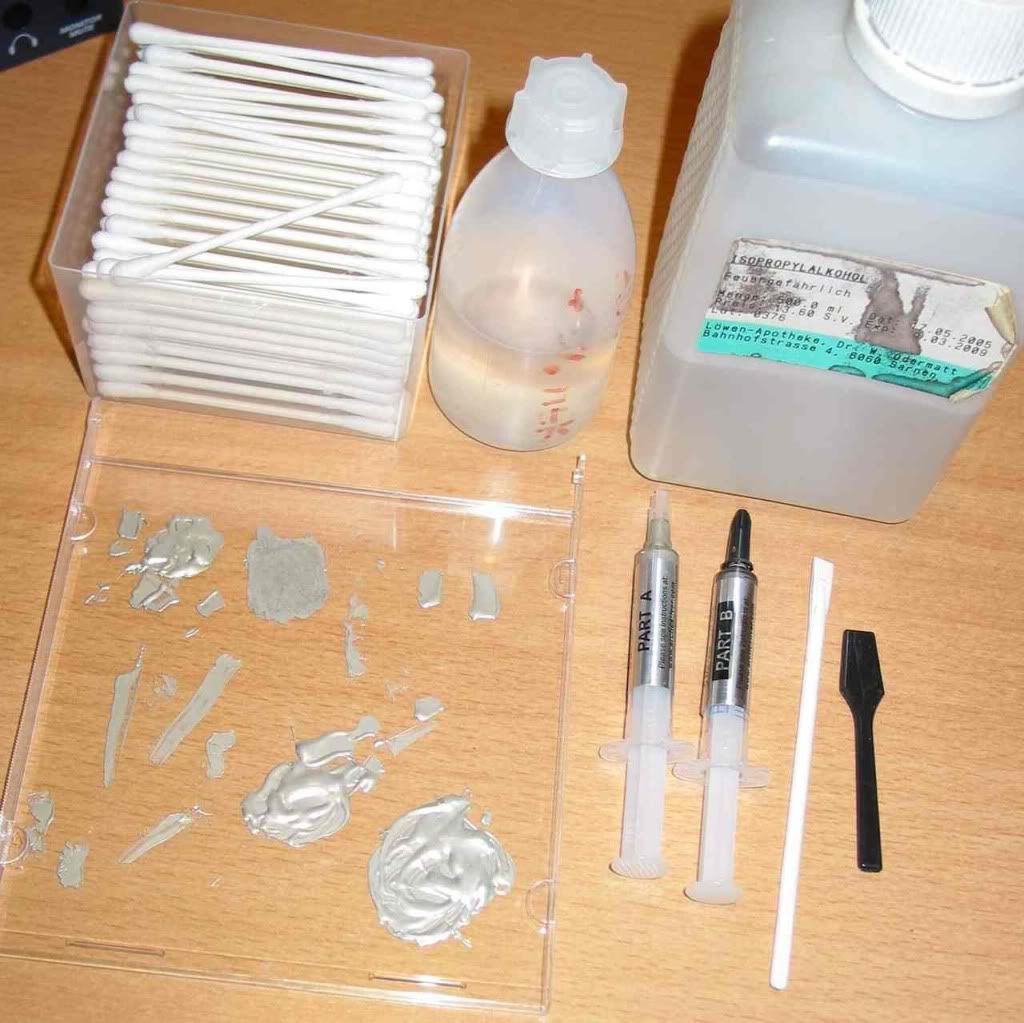 A bunch of heatsinks:  And an UCA222 that got a heatsink on the DAC/ADC chip: 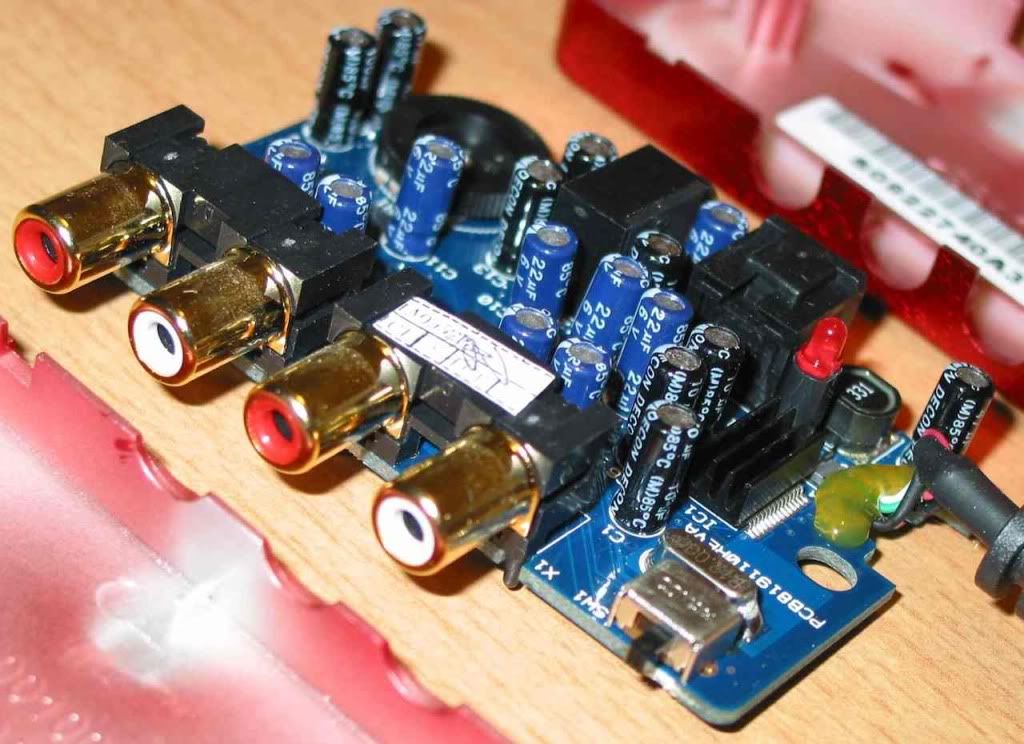 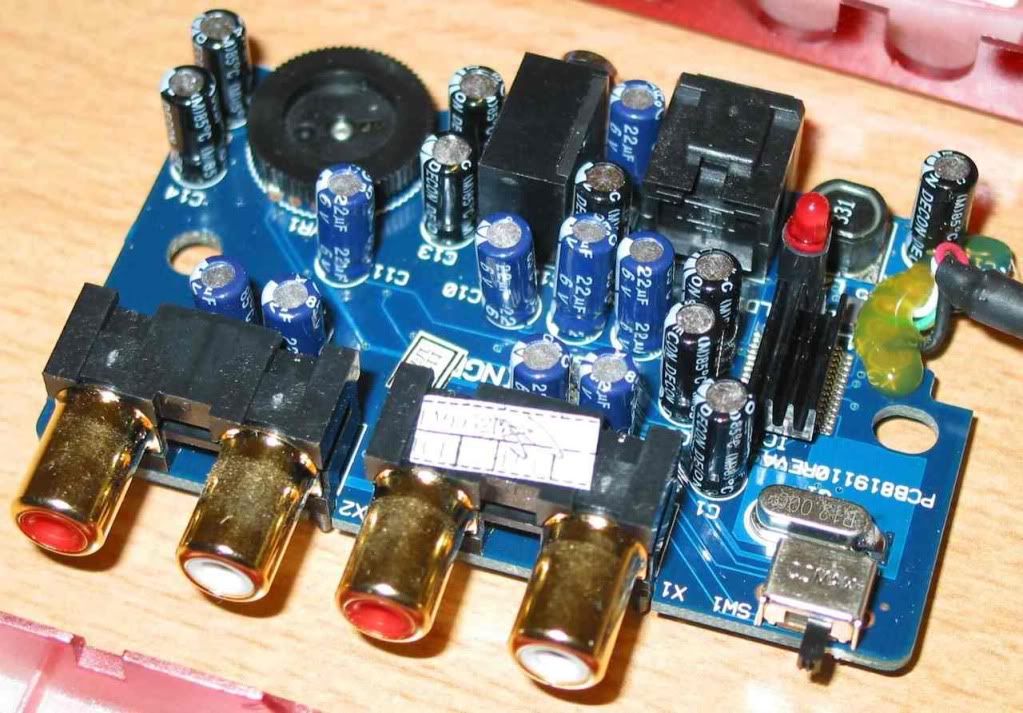 Also a picture of the backside of the PCB: 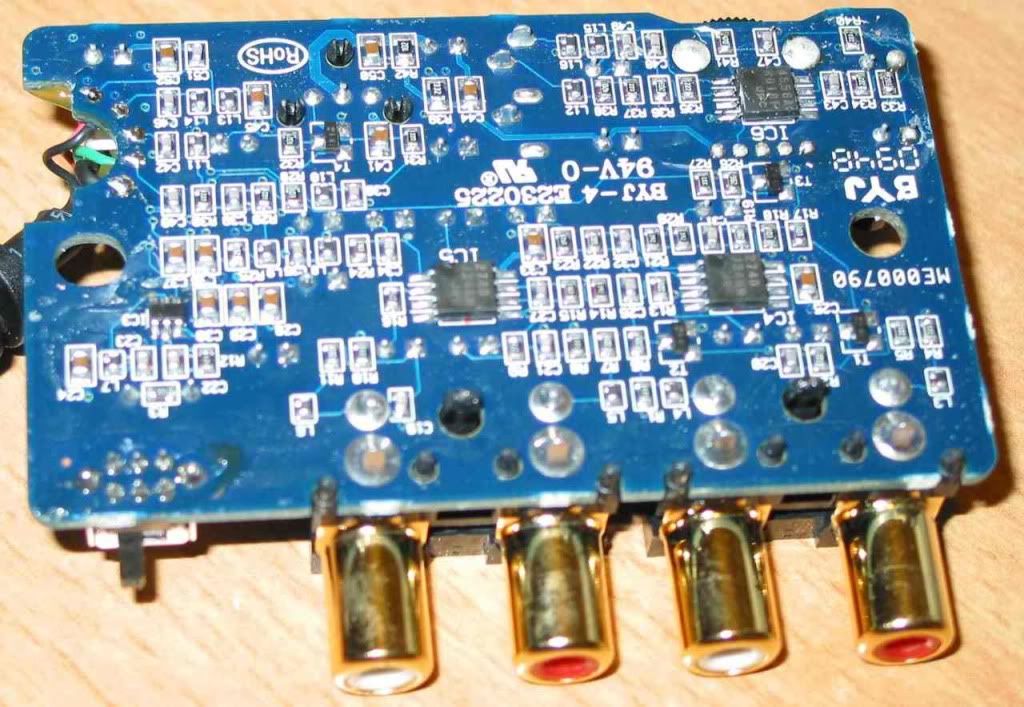 I can't comment about possible improvements at the moment. I'd very suprised if there would be a big difference (if any). At least it should have no negative effect. I've fitted the heatsinks because Alex suggested it for the opamps of the PreSonus HP4 amp. I decided also to fit heatsinks on the UCA222 and the AUNE Nano USB DAC. It will be interesting to see if there's any difference in SQ. Something else to think about. Based on quite a few people's experiences when replacing I.C.s such as the LM4562 DIP8 with a metal can version, ánd other reports about an improvement when some DIP8 dual opamps have mini adhesive heatsinks fitted, it seems possible that even though using the same chips internally, that the SOIC versions may not sound quite as good as their bigger DIP8 brothers due to running even hotter. It could be interesting to fit a small adhesive heatsink to these quads, and see if you can hear an improvement. N.B. This is just a gut feeling. Alex Christian Most people who have tried the LM4562HA/LME49710HA dual metal can I.C.s agree that the metal can version sounds more refined, and easier to listen to than the DIP8 plastic version. Still, most people feel the need to slip a heatsink on it, as it gets quite warm to the touch. Yet the DIP8 version has the same chip inside it, and must get damn hot internally. I think the improvement may come down to better thermal management ? Is it a coincidence that some of the best sounding I.C.s also have very low distortion figures when correctly implemented.Yet according to dusty old textbooks, we are not supposed to be able to be aware of distortion at levels 100s of times higher, as long as they are below .01% !  Alex
|
|






















 ).
). 










